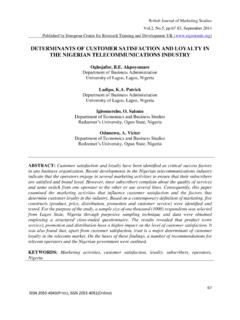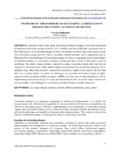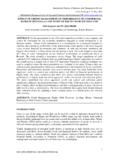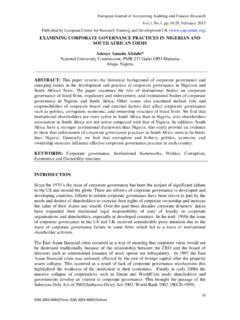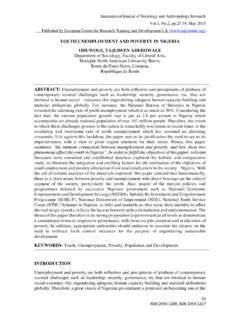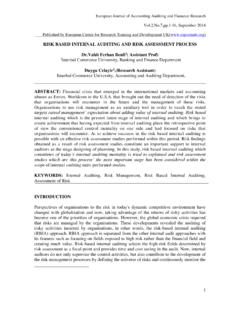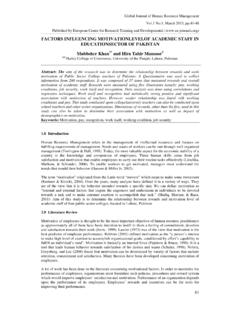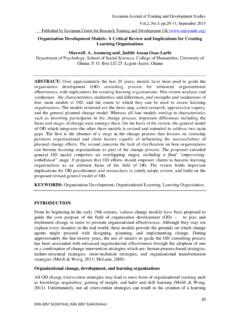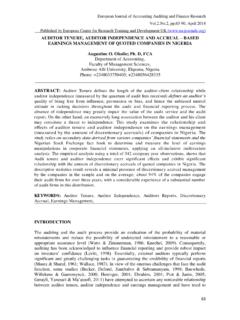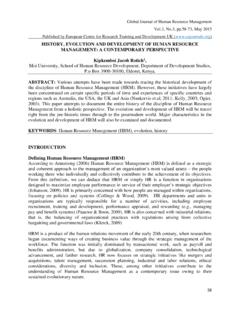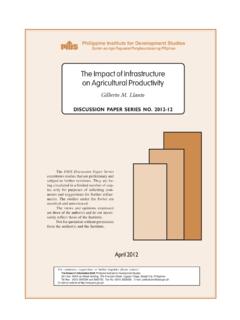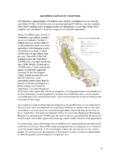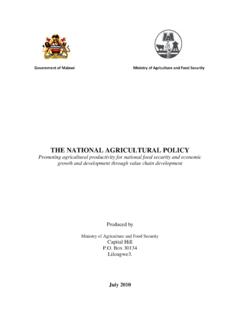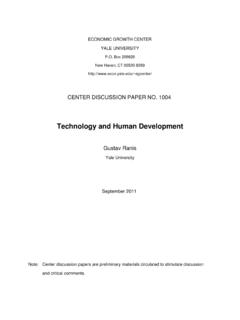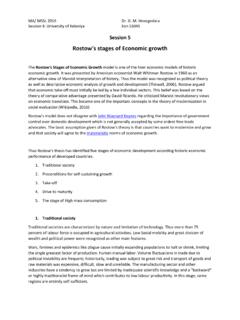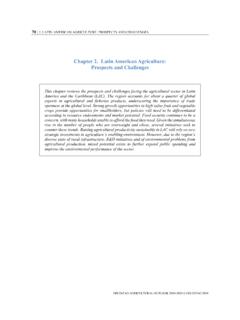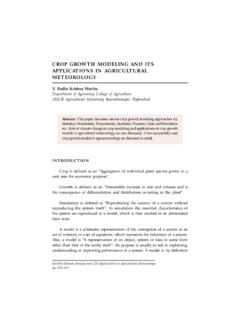Transcription of Impact of Agricultural Export on Economic Growth
1 International Journal of Business and Management Review Vol. 1, , March 2013, Published by European Centre for Research Training and Development UK ( .org) 44 Impact OF Agricultural Export ON Economic Growth IN CAMEROON: CASE OF BANANA, COFFEE AND COCOA Dr. Noula Armand Gilbert (Senior Lecturer), Sama Gustave Linyong (PhD student) Gwah Munchunga Divine ( ) Faculty of Economics and Management: Department of Economic Analysis & Policy University of Dschang Cameroon Abstract: The main objective of the present analysis is to explore and quantify the contribution of Agricultural exports to Economic Growth in Cameroon. It employs an extended generalized Cobb Douglas production function model, using food and Agricultural organization data and World Bank Data from 1975 to 2009. All variables were non stationary and of an order I (1), so the Cointegration test was conducted for long run equilibrium.
2 All the variables confirmed cointegration and as such the conventional vector error correction model was estimated using the Engle and Granger procedure. The findings of the study show that the Agricultural exports have mixed effect on Economic Growth in Cameroon. Coffee Export and banana Export has a positive and significant relationship with Economic Growth . On the other hand, cocoa Export was found to have a negative and insignificant effect on Economic Growth . Base on our findings, it is recommended that policies aimed at increasing the productivity and quality of these cash crops should be implemented. Also additional value should be added to cocoa and coffee beans before exporting. When this is done, it will lead to a higher rate of Economic Growth in Cameroon . Keywords: Agricultural Export , Economic Growth , Cointegration, Vector Error Correction Model, Cameroon General Introduction There is an increasing interest in the relationship between Export and Economic Growth .
3 Theoretically, it has been argued that a change in Export rates could change output. Export Growth , therefore, is often considered to be a main determinant of the production and employment Growth of an economy which is shown in Gross Domestic Product (GDP) Growth (Ramos, 2001). The most important and crucial aim of the developing countries in general and Cameroon in particular is to achieve a rapid Economic Growth and development and exports are generally perceived as a motivating factor for Economic Growth . The desire for rapid Economic Growth in developing countries is attained through more trade. There is no shortage of empirical and theoretical studies regarding the role of exports in raising the Economic Growth and development of a country. The classical economists like Adam Smith and David Ricardo have argued that international trade is the main source of Economic Growth and more Economic gain is attained from specialization.
4 According to the Export led Growth hypothesis, exports being the major source of Economic Growth have many theoretical justifications. First, in Keynesian theory more exports generate more income Growth through foreign exchange multiplier1 in the short run. Second, Export raises more foreign exchange which is used to purchase commodities such 1 Foreign trade multiplier also known as Export multiplier may be defined as the amount by which national income of a nation will be raised by a unit increase in domestic investment on exports. As exports increase there is an increase in the income of all persons associated with the exports industries. International Journal of Business and Management Review Vol. 1, , March 2013, Published by European Centre for Research Training and Development UK (.)
5 Org) 45 as machinery, electrical and transport equipment, fuel and food which is motivating factors for the Economic Growth of any nation. Third, exports indirectly promote Growth via increased competition, economies of scale, technological development, and increased capacity utilization. Fourth, many positive externalities like more efficient management or reduction of organizational inefficiencies, better production techniques, positive learning from foreign rivals and technical expertise, about product design are accrued due to more exports, leading to Economic Growth . In fact, over the past decade, Cameroon, like other countries in sub-Saharan Africa (SSA), has experienced a dramatic decrease in Export Growth in general, and Agricultural exports in particular, causing problems that need to be solved urgently (Amin, 2002).
6 There are two main largely opposing schools of thought explaining the decline in Agricultural exports. One stresses factors that are external to the individual country: such as the slow volume of Growth of world primary commodity markets and the deteriorating terms of trade. The other school of thought emphasizes factors that are internal to the country, that is, the domestic policies that have affected Export supply adversely. In brief, the arguments are that the cumulative effect of government s Agricultural policies has tilted domestic producer prices downwards and thus reduced Export supply. Also the explicit taxation of Agricultural exports by marketing boards as well as the relative neglect of the sector in overall development planning, has brought down both domestic producer prices and Export supply. Cameroon s economy is predominantly agrarian and agriculture with the exploitation of both renewable and exhaustible natural resources remaining the driving force for the country s Economic Growth .
7 Cameroon s economy performed very well for the period 1961to1985, with agriculture supporting the economy from sector plays a pivotal role in the economy and exerts important effects on other sectors. Before the beginning of crude oil exports in 1978, agriculture accounted for about 30% of the gross domestic product (GDP) and 80% of total exports. With the advent of oil, the share of agriculture in GDP declined to 24% by 1987, before increasing to 27% in 1990, and its contribution to Export earnings fell to 53% (MINEFI, 1981, 1993; McMillan, 1998). The two decades immediately after independence (1960s and 1970s) Cameroon experienced considerable Growth in production and in earnings from Agricultural exports. Between 1965 and 1980, Agricultural output grew by (World Bank, 1989). During the period when agriculture was the dominant Economic activity the country depended on it for non-oil foreign earnings.
8 It accounted for almost 34% of GDP, employing 80% of the labour force with 85% of the total population of the country deriving their livelihood from it and providing 85% of exports (Daniel Gbetnkom and Sunday A. Khan, 2002). The manufacturing sector grew rapidly, although on the whole the Agricultural sector was stagnant with varied rates of Growth across commodities. The food production sector grew, while the Export crop production sector declined. After more than two decades of rapid Economic Growth , Cameroon s economy collapsed in the mid-1980s to late 1990s (partly because of the sharp fall in world prices for its main Export commodities, corruption and cronyism and poor domestic Economic management). The decline in the GDP Growth was sudden and severe, from 8% to less than -5% per year for the period. Because the period of Economic expansion was much longer than that for Economic contraction and given the stylized facts2, the magnitude of the Economic decline was unexpected and devastating.
9 Given that the overall success of the Agricultural Export promotion strategy will depend among other things on what factors constrain Export Growth and on the responsiveness of producers to changes in price and non-price 2 Stylized facts are introduced by the economist Nicholas Kaldor in the context of a debate on Economic Growth theory in 1961, expanding on model assumptions made in a 1957 paper. In social sciences, especially economics, a stylized fact is a simplified presentation of an empirical finding. A stylized fact is often a broad generalization that summarizes some complicated statistical calculations, which although essentially true may have inaccuracies in the detail. International Journal of Business and Management Review Vol. 1, , March 2013, Published by European Centre for Research Training and Development UK (.)
10 Org) 46 incentive structures. A better understanding of key variables affecting Export performance and the direction and magnitude of the relevant elasticities is desirable. (Amin, A. A. 1996) Despite this downward trend, the sector still plays a leading role in the economy. This strength comes principally from the Export crop sub sector, which is based on cocoa, coffee, cotton, timber, banana, rubber, palm oil and tobacco etc. The first three of these crops account for the lion s share of Cameroon s Agricultural Export earnings. Before 1978, it contributed 65% of total exports and 88% of Agricultural Export revenue, with 28% for cocoa, 55% for coffee and 5% for cotton. After 1978, their contribution declined slightly, to about 81% of Agricultural Export earnings, with cocoa contributing 29%, coffee 44% and cotton 8% (Gbetnkom, 1996; BAD/FAD, 1992).
